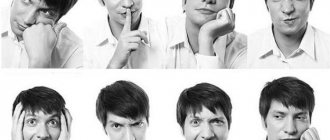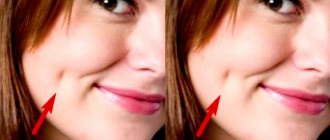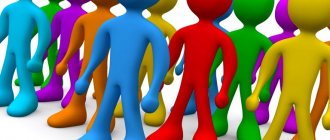Books of the Sophists
Physiognomy is a science with deep roots. For the first time, the term “physiognomy” was used by the “father of medicine” - Hippocrates. At different times, physiognomy researchers were called heretics, charlatans and prophets, “God’s messengers.” The books of the Sophists are considered to be the first works on physiognomy. Sophists are ancient researchers of paradoxes and contradictions, teachers of eloquence. Such works of sophists as “The Book of Physiognomy” by Esphren and “Face and Character” by Afronisius have reached our time.
What do the faces say?
You can’t help but trust a person who has been collecting information for a book for more than 40 years.
Psychologist Robert Whiteside made physiognomy popular among ordinary people with his fundamental work “What Faces Say.” What Faces Say is richly illustrated and represents much of human emotion. Fans of this book say that it helps determine a person's character even before he utters a word. Although such enthusiastic claims are not easy to trust, What Faces Say became a worldwide bestseller and has sold more than three million copies.
"Fool me"
The series “Lie to me” has become a cult series thanks to its plot related to physiognomy.
The hero of the film, Dr. Lightman, knows how to expose human lies by a person’s facial expressions and gestures, and the intonation of speech. His advice is used by federal agencies and investigators when considering the innocence (guilty) of suspects. The ability to distinguish “facial expressions of lies” is one of the most important tasks of the science of physiognomy. There are a number of books on this topic. The book of the American scientist Paul Ekman “The Psychology of Lies. Fool Me If You Can" is a captivating piece of non-fiction. In addition to being related to the series, it covers vital techniques for detecting lies in real life.
Encyclopedia of Occult Sciences. Book II. Physiognomy
Preface
I
There is a very interesting method of solving astrological problems without the use of calculations and Kabbalistic techniques (as, for example, in the works of Eli Star) - an experimental search for what is called astral signs.
These signs on the body correspond to special psychological characteristics. This is where physiognomy came from.
In physiognomy there are two methods that reinforce each other. One, completely analytical, consists of collecting individual observations and classifying them into summary tables. The other, synthetic, is based on the general principles of occultism and comes from astrology.
I will talk about the first method later. But it should be noted that the second method obtains the same results, and this clearly shows: whether astrology is provable or not, everything happens according to its laws.
Indeed, in every thing, in every being there is a sign placed by the mysterious Unknown, whom we call the creator, nature, the astral stream and God. There are types of people who can be classified according to geography and occult, undeniable laws formulated long ago. Regardless of what to apply: the purely physiological physiognomy of Lavater, revived by Gastin, or the planetary typology of Ledos, modern morphology, the astrological palmistry of Debarolle or the experimental palmistry of Remus, ordinary graphology or intuitive synthesis, the results are the same: we come to a sign that, without any objections can be called astral for ease of presentation. But this simplicity expresses astrological truth.
And this sign is, according to Decresp, the exact expression of the planetary influence that a person receives in the womb. Thus, at the moment of birth we have a special vibrational tone, we are formed in accordance with a certain physical and mental intensity. This is what shapes our destiny.
The theories of heredity and geographical position (the influence of latitude, climate, geology) are insufficient, however true and important they may be, to explain this sign, which fits well with free will, for will is also one of their innate properties. Does this heredity pass from one life to another? Occultism says yes. I am not trying to resolve this important issue here; I just want to draw your attention to it.
And how many such signs can be found in nature! Think with Stanislas de Guaita [1] about how the sight of an octopus, a scorpion, a crocodile evokes fear, how various representatives of the cat, like birds of prey, bear the mark of cruelty, but this cruelty does not strike the attacker with the obvious uncleanliness, there is nobility in it a warrior[2] who wants to show himself. Pay attention to how poisonous plants and mushrooms look[3], to the datura with its crimson flowers, to the henbane with its repulsive smell, to the spurge with its caustic juice, to the hemlock with its suspicious rustiness...
Strindberg [4] gave excellent descriptions of a moth called the Death's Head, a caterpillar that feeds on the toxic daturine and solanine of poisonous plants, certain plants that smell of death (such as arum and orchis) and attract insects that feed on carrion. There are even minerals that bear signs - even hard silex and brittle sandstone; other minerals have a strange shape, bearing something like portraits, landscapes, carved or engraved on their surface. And some occultists claim that this is not just an accident.
Paracelsus himself eloquently described this universal sign in his medieval French; he and other researchers tried to study it to unravel the underlying principles of its creation. This sign is proof of the analogy between the form of a being and its inner nature; it is this sign that underlies astrology.
II
And therefore, there is a certain order in which the occult sciences must follow and which the author of the encyclopedia has preserved: astrology is at the core of everything, then three systems about the astral sign - a) physiognomy, b) palmistry (essentially this is physiognomy applied to the hand), c) graphology (this is the result of the sign of palmistry. These four sciences constitute, as I have already said, the deductive sciences of prediction.
If one can argue with Madame de Tabb[5], Madame Fraya[6], Remus and other palmists who claim that no astrology is needed to read hand signs; if graphologists do not use a single word from the astral dictionary (which, however, is popular in physiological palmistry), then this can be considered normal only in relation to the results. It is not true that the occultist or anyone else with a synthetic mentality makes a mistake in his attempt to unite these sciences with each other and even with the intuitive and metaphysical sciences, with alchemy and magic, for it is in this way that one can obtain a single whole - similar to the great religious doctrine - a real temple in which harmony reigns in everything, from the strong foundation at the base to the most exquisite sculptures at the top.
For the occultist, in reality the Universe is centered in man, the microcosm is governed by the macrocosm, the astral sign can be found everywhere - on the face, hand, in handwriting - it is a secret and sacred language that says what needs to be said when we approach the solution of any mystery . And now we can talk with all responsibility about physiognomy. This is not just a study of the face, as ordinary people think, although, judging by the etymology of the word, this is exactly the case (physis - nature, gnosis - knowledge). In fact, this is the study of the entire external appearance of a person as a whole, from which it follows that palmistry, in principle, should also be included here, but it exists as a separate science due to its importance.
Do I need to prove the importance of physiognomy? She does not have the bad reputation of her mother astrology. This can be observed. Isn’t he a physiognomist who says about someone’s head “beautiful” or “disgusting” (in the ethical sense of the word)? And aren’t we doing instinctive astrology when we talk about people who were “born under a lucky star” or simply “walking misfortunes”? Who hasn’t had fun looking at passers-by, trying to guess their character and social status by their appearance?
According to the facts, there are aristocratic faces (title and nobility have no meaning here) and plebeian faces, the face of a drunkard and the pretty face of a girl in love, the healthy face of an active person, the masked face of a bandit, the majestic type - the face of a judge, the domestic type, the typical faces of a soldier , priest, scientist. It is true that clothes sometimes help; but still the character leaves its mark on the facial features. It was only necessary to study and classify these signs to create a science. This is not a new idea, but it was necessary to organize a system, which is what Lavater tried to do[7].
But where Lavater, Delestre and other physio-psychologists stop, the occultist goes further and, imbued with the ideas of astrology, says in turn:
“You notice the signs of the stars without saying a word; you say that a person is choleric just by looking at his face; he is like this because he was born under the unfavorable influence of Mars. We have come to the same result, but observation is enough for you, but I am interested in the reasons. Isn't it more interesting to try to guess that a person will have a choleric character if he was influenced by this or that planet? This is not only more interesting, but also useful: if we also issued a horoscope along with the birth certificate, it would be much easier for parents to raise their children.
So, if (I repeat) everything happens according to astrological information, even if it cannot be proven, can we talk about a theory of (practical and reasonable) planetary typology[8]? It can be talked about without any mysticism, as was done by Paul Jagot, who drew a diagram of planetary types in accordance with modern tradition and pointed out the correspondence of morphological signs with physiological, pathological, psychological, chirological and graphological characteristics, adding predictions for these types.
And returning to the pleasure of people-watching, I confess that there is nothing more attractive than sitting on the terrace of a cafe and giving yourself completely to this activity: analyzing passers-by with just one glance, which with practice becomes fluent and true, and you see these people better than if they came straight to your table. And the internal monologue captivates you, such as: “A very interesting head, all consisting of round segments. The face is white, uninteresting, lifeless, like a star in the night sky. Round and bulging eyes with a stamp of melancholy and dreaminess. The mouth is small, half-open, with thick lips. He has a soft, indifferent voice. His movements are sluggish and slow. He seems passive and submissive, he must be impressionable, indecisive, strange. He has a rich imagination, he is weak, timid. I bet he loves to travel and suffers from fits of rage. He has a lunar sign."
But this lunar type goes further. The one who follows him is a muscular big man, tall, with narrow hips, a square face, a sloping forehead, a sharp nose, and thin lips.
“Oh,” you exclaim, “what a stern look! Although he is not wearing a military uniform, he clearly deserves one. His life must be one of eternal strategies, whether he is a businessman or an administrator somewhere. I think he is combative, disciplined or ruthless. I'm afraid he's passionate, maybe cruel. And I would like to feel sorry for his wife, if he has one. I'm sure he has a clear, willful handwriting with a heavily crossed out t. If I had looked at his hand, I would probably have found a sign of violent death."
The son of the planet of war walks quickly. A woman follows him. She belongs to the Venus type, not because she is an attractive woman (there are Venus type people without much beauty), but because she seems to consist entirely of elliptical curves. Her oval face, white with a slight blush, is illuminated by beautifully shaped eyes under a clean line of eyebrows. “What a classic nose, a little aquiline; what a delicious mouth with such a Cupid's curve that you can't help but kiss it. Small, but with perfect proportions. A fairly reasonable facial expression speaks of a pleasant and sensual voluptuousness. Her fingers are pointed. There is no doubt - artistic nature. A! Here she enters the theater through a door not intended for strangers.
In fact, these are very specific astral types. You'll be lucky if they pass you by, as this happens very rarely. Almost all people are of mixed type. An expert analyst is able to discern some of the dual influences of the planets: here is a Mars-Mercury type person, energetic, but flexible and graceful, with numerous and quick gestures; here is the Jupiter-Apollo type, combining noble balance of mind with aesthetic courage; Here is the Saturn-Venus type, meek like a woman and serious like a scientist. But whatever the type, it is always marked, it has its own sign. And the one who plays the game of recognizing character in passers-by has the power and ability to manage his own life well.
PHYSIOGNOMY
I.
Sections of physiognomy and its brief history.
Anyone who has bothered to read the introduction to this book can guess for themselves what sections they will see in this chapter:
1. Purely morphological physiognomy;
2. Phrenology (physiognomy of the skull);
3. Chirology (physiognomy of the hand);
4. Typology (planetary physiognomy).
Due to the enormous importance of chirology, we will study it separately; it is also divided into 2 parts: morphological and astrological.
Physiognomy is the study of the appearance of a person as a whole, and not just his face, although this is undoubtedly the most important subject of study of this science, which appeared in order to recognize obvious connections between the physical and mental.
These connections were discovered long before Lavater and served as the basis for some practical conclusions. Already the Greeks felt their presence so much that in their language they combined two words kalos “beautiful” and agathos “good”. And it turned out kalosagathos, which means “honest, good person.”
According to ancient Greek ideas, before a human being can be called a human being, his name must combine beauty and kindness.
Among the Romans, the word persona (from which the English word personality comes) originally meant a mask in which an actor played his role. Hence, “personality” is literally and figuratively a mask with which one can establish the character and future of a person[9].
Long before Lambroso, Penschel, Pernetti, Harder, Cubisse and Delestre, the ancients maintained that a certain face reflected a certain character corresponding to certain abilities.
It was Aristotle, we think, who was the first to highlight the connections (as clearly stated in Lavater's work) between human faces and animal heads[10]. This was also known to the philosopher Zopirus and the physician Hippocrates; in the Middle Ages and closer to our time, Cureau de Lachambre, the physician of Louis XIV, Porta and Adamantius, Pierre Dalban and Cardon, Michael Scott and Claramontius, Montaigne, Bacon and others wrote about this.
Montaigne wrote: “Some faces appear lucky and others do not, and I think there is some way of distinguishing between good and idiotic faces, stern and hard, angry and sad, contemptuous and depressed, and other similar qualities and emotions.” .
Long before him, Marcus Aurelius wrote: “A man full of sincerity and purity emits a characteristic aroma; it can be felt; his whole soul, his whole character is reflected in his face and eyes.”
And before Marcus Aurelius, Solomon wrote: “As the face of those who look into it reflects, so the heart of a person is open to the eyes of the wise.”
Delestre, in his magnificent "Physiognomy" (1866), offers a list of works written before Lavater on this subject and related palmistry: "The Art of Palmistry" by the master Andrien Corum, a small undated incunabulum printed by Jean de Verdelley, a small treatise by Michael Scott, the occultist 13th century, the first edition of which cannot be dated earlier than 1508, a Latin essay on palmistry by Andre Corvo, Manual of Physiognomy (Krakow, 1532), Palmistry Tricassia, based entirely on astrology and translated into French, Geomancy by Pierre Dalbano , “Physiognomy” by Molinius, the book of Thaddeus Hages (1565), where physiology first appears, “Treatise on the Study of the Hand” by Picciolo, who quotes more than 50 of his predecessors, the wonderful book “On Human Physiognomy” by Porta, work on metoposcopy and ophthalmoscopy by Fusius (1615 ), works by Finella of May - on medical palmistry (1665), Ronfil, Saysir and many others.
The fact that we have dared to give such a large list was only intended to show how much this science captivates the seekers, the pioneers who prepared the roads for further exploration, with their methodical and critical genius of Lavater and Gall, later of Debarolle, Gastin and Jagot.
Let us also remember Saint-Simon, the keen observer, who writes in his memoirs: “One must have only eyes, and no knowledge of the court at all, to see the interests expressed by their faces.”
Camper and Gall brought precision to physiognomy when it was still in its infancy. But, as we have already said, the honor of founding this science belongs to Lavater.
Jean Gaspard Lavaterre, a Swiss son of a doctor, early discovered his penchant for reflection. He studied theology and was appointed pastor in 1775. His sermons were always attended by many people. He wrote no less than 129 books, the most famous of which was and remains his Essay on Physiognomy.
II.
General
Everyone knows that when you meet a new person face to face, you may feel affection towards him, or indifference, or hostility, it actually depends on the impression that this person makes on you, i.e. whether he expresses it is sincerity, kindness, intelligence, or depression, stupidity, anger, severity, insincerity, cruelty.
But it is not only the face that conveys information to us without words. These are also movements, posture, gait, manner of dressing, listening, speaking. This person does not even suspect how closely others are looking at his appearance, and this one slowly measures the room with his steps, stooped, pathetic, while the other one walks straight, proudly, self-confident. And here we are dealing with a serious type with restrained movements and slow speech. And this man is extremely excited, a “rigolo”, a talker.
No two people are exactly alike, but we immediately (and sometimes too quickly) judge them. How often do we begin to treat a person friendly just because he has pleasant manners, he is correct and good-natured. And, on the other hand, how often do we not want to see someone again because “I didn’t like his face.”
Based on this information, which (as you will see) consists only of the study of the face (superficial or thorough), Lavater divided this science into four parts:
1. Natural physiognomy (related to temperament), which studies the human constitution, the quality of his blood and organs (fragile or rough), his adaptability, excitability (irritability);
2. Intellectual physiognomy – deals with the external functions of the mind, manifested in the face, complexion, gestures;
3. Moral physiognomy – inclination towards good or evil;
4. Medical physiognomy – visible signs of illness or health.
On the other hand, we divided his observations into 6 categories, depending on what they relate to: face, demeanor, voice, tissue structure, complexion, hair.
Since then, all this has been simplified, and F. Clerger (who wisely asks us not to judge a person based on such little things, but to study him as a whole and draw a general conclusion on all parameters) divides physiognomy into 3 parts:
1. relating to mental life (study of the frontal part);
2. relating to moral life (which gives liveliness to facial features);
3. relating to material and organic life (attitudes and gestures).
We will combine two methods.
But first, a few remarks from Gaston Robert's book[11] about ugliness and beauty, the appearance of strength and weakness, physiognomic differences between men and women, family resemblance, national physiognomy, physiognomy of ages and temperaments, profiles and silhouettes.
In principle, says Robert, virtue brings beauty, vice brings ugliness. But there are ugly people full of virtues and beautiful women full of evil. But “look at the expression on a person’s face when he is directly confronted with evil, and you will see how different it is from those who have never sinned.”
In the same way, we recognize in ugly people, brightened by noble emotions, our beauty, which always accompanies virtues.
According to Lavater, a very beautiful face - a pseudo-superhuman one - should have:
a) amazing equality between three parts: forehead, nose, chin;
b) a forehead that ends straight, hence the eyebrows are straight, narrow and clear;
c) blue or light brown eyes, which appear black from a distance, and upper eyelids covering 4/5 of the eyeball;
d) a nose with a large bridge, almost straight and slightly inclined;
e) straight mouth with a clearly visible curve, equal lips;
f) round and prominent chin;
g) short dark hair, curled into large ringlets.
Napoleon I
The last characteristic is dubious. The existence of the rest together is rare. These traits are, for example, found in Napoleon I and Madame Recamier.
According to Lavater, human strength in its outer expression is calm and cheerful. Some Hercules are courage itself, massive, endowed with the strength of a colossus. Other strongmen seem flexible. If a Herculean man has flab, then he is actually not that strong, this is easy to notice.
Signs of real strength are a strong physique, a thick neck, broad shoulders, a face with prominent jaws (a person with a well-fed face is unlikely to be strong), modest behavior, a confident gait, and a voice of average volume.
Apparent strength can only be noticed by chance; it is possessed by people who are more likely to be thin than plump, tall, taciturn, with a piercing gaze, thin lips.
Physiognomic signs of weakness are very tall stature, thin physique, soft skin, nose and forehead are too round, chin and nostrils are somewhat small, uncertain gait and gestures.
Since Lavater's time, these signs of strength and athleticism have been studied with particular care due to the fact that physical training and sports have become the subject of many scientific studies.
Ideal types according to Greek sculptors
You can find accurate and practical information on this topic in special books; they are beyond the scope of our interests.
There are physiognomic differences between men and women.
A woman's shape is all round. The fabrics are delicate and flexible, they soften angles and different parts of the body blend gently into each other. The muscles are very mobile, they do not contract for a long time, so they do not change their faces like the faces of men when they are overcome by passion; it is impossible to know from a woman’s face what is occupied by her heart and thoughts.
Hence, in the science with which we are dealing, women are small assistants. Nevertheless, it is easier to recognize at first glance a proud woman (straight posture, raised head, slightly contemptuous mouth, look from above), a hypocrite (she, like a man, has a cunning look, if not a cynical one, she is not afraid to look you in the eye) , a dignified poor woman with a suffering and submissive face, a professional beggar with her head bowed, moaning pitifully and constantly sighing, to distinguish a decent woman from a cheerful and instinctively provocative one, a shy girl from a vain one, an ignorant from an educated one, a simple woman from a modestly dressed aristocrat.
One piece of advice: don't trust a sharp nose and especially thin lips. It is well known that a woman with thin lips has a terrible character, grumpy, cruel, heartless.
Admire bright red full lips: they usually belong to loving people and passionate lovers.
G. Robert makes the following comments regarding family physiognomy:
1. usually very smart children are born from a stupid father and a smart mother;
2. from a father who is good by nature, children inherit good character;
3. if the father is good, the sons borrow their moral values from him, and their intellect from the mother. Daughters usually inherit their mother's soul;
4. You need to monitor your newborn baby, because children are most similar to their parents during the first hours. This similarity will return only after a few years;
5. if the physical similarity of children increases as they grow, the same will happen with their intellectual growth;
6. one inherits strength or weakness from the father, not the shape of bones or muscles. From the mother - the quality of nerves, the shape of the face, if the child is the fruit of first love (for example, a widow is an exception). Naturalists have noticed that a bitch always gives her puppies signs of the species of the animal from which she first became pregnant;
7. If a child is like both parents, he will eventually lean towards the one who loves him more;
8. if the mother or father has a hot-tempered, unbridled character, bringing it back to normal can take centuries;
9. a phlegmatic character is the most difficult to inherit;
10. An active, hardworking, observant character is almost ineradicable.
National physiognomy is a kind of expansion of the field of family physiognomy, which applies to the entire nation.
Human races can be distinguished not only by the color of their skin, but also by their features.
The Caucasian type is the only type that is extremely light and has the greatest variety of features; Tatars are very similar to each other, as well as Mongols, Chinese, Malays. If they are the same age, it can be very difficult for Europeans to distinguish them. Great diversity in the American race, but between tribes. We won't go into detail about human types; that would take us too far and it wouldn't be very helpful.
But we would like to say a few words about the physiognomy of age.
“The child,” says Robert, “has a short and wide face, the forehead protrudes forward, the cheeks are smooth and plump, the lips are fresh and bright, the skin is soft, tender and pink, all forms are round and cute.”
“During adolescence, the bones of the face develop, the nose becomes sharper, the cheeks become longer, the Downs begin to show themselves, the gaze becomes more confident, the colors become duller, the face acquires expression, feelings find their imprint on the face, which later turns into wrinkles.
An adult has more pronounced features, but less mobile. By the face you can recognize nationality, family, character and temperament.
The face of an old man lacks brightness, his features are coarsened, his skin is dry and wrinkled, his eyes lose light, his shape becomes angular, his face loses mobility.
III.
Physiognomic tables.
Temperaments and characteristics.
Choleric.
The eyebrows are thick, the tip of the nose is pointed, the lips are thin, the eyes are characteristic, but alarming and impudent. The complexion is often dark or yellowish (if the person is irritable), the hair is dark, coarse and well styled, and the teeth are healthy.
Phlegmatic person.
The shape is sluggish (those with arched eyes), the lower lip protrudes forward, the gaze is lifeless, the complexion is dull, the hair is usually light (often thin and bulky), the teeth are uneven and slightly bluish.
Sanguine.
The face is full, blooming, bright lips, healthy teeth, lush hair, eyes are often blue, cheerful, showing frivolity and a love of pleasure.
Melancholic.
The nose is inclined towards the closed mouth, small nostrils, thin lips (the lower one protrudes), small chin, wrinkled forehead, sad look, sunken cheeks, pale complexion.
End of introductory fragment. Buy full version.
Footnotes
1
Guaita Stanislas de (also pronounced as Guaita, Guaita, Zhuay; Stanislas de Guaita, marquis, b. 04/06/1862 in Altville, Lorraine, d. 1897 in Paris): French occultist of the second half. XIX century, “neo-Martinist”, in the 80s. basic “The Kabbalistic Order of the Cross + Rose” (the so-called “secondary Rosicrucians”), whose main work was the republication, translation and commentary of classical works on occultism. In 1893, G. was suspected of an “occult attack” on the leader of the mystical “Carmel Church” J.-A. Bullana, which resulted in the death of the latter, and was even challenged to a duel by one journalist. However, both opponents escaped with only minor injuries. The cause of Bullan's death was actually his own actions. Guaita's own death was the result of a drug overdose. (Editor's note).
2
Especially an ancient warrior who believed more that he was fulfilling a great mission. In this respect, observe how carefully the sculptor always tried to show military prowess. (Author's note).
3
Undoubtedly, objections will follow that the difficulties in distinguishing a poisonous mushroom from an edible one make this idea untenable, which we only touch upon superficially here. Only an expert can say that a mushroom is poisonous because “it looks bad”; He discovers this with ease, unlike the average person. (Author's note).
4
Strindberg Johan August (January 22, 1849, Stockholm - May 14, 1912, ibid.), Swedish writer, prose writer, playwright. The most lively and original part of his legacy were his plays, and he himself, along with A. P. Chekhov, M. Maeterlinck, G. Hauptmann and G. Ibsen, is considered one of the creators and theorists of the new drama. (Editor's note).
5
Madame Tabb (Thebes) is a famous French palmist, author of books on palmistry, which were widely reprinted in pre-revolutionary Russia. (Editor's note). (Editor's note).
6
Madame Fraya is a renowned French researcher of handwriting, a specialist in graphology and palmistry, and the author of a number of manuals. (Editor's note).
7
Lavater Johann Caspar (1741–1801), Swiss pastor, writer. Wrote in German. The novel “Pontius Pilate, or the Little Bible” (1782-85), the drama “Abraham and Isaac” (1776) - of a religious nature; lyric poems. The most famous is his treatise on physiognomy “Physiognomic Fragments”. (Editor's note).
8
See the books: “Features of the occult sciences and practical magic”, “Discoveries of Destin” and others (Druin publishing house). (Author's note).
9
This mask of the ancient actor was irremovable; she represented his soul, his entire psychology. Long before Lavater, this mask was removed only because neither the soul nor the face is immutable. Both of them change under the influence of will. The severity of the ancient mask was a symbol of fate, its theoretical immutability.
10
As you know, the artist Le Brun painted a series of wonderful paintings in which these connections are shown in pairs: the head of an animal and next to it the head of a man with the same characteristics, a lion and a man with the features of a lion, a dog and a man with a dog’s face.
11
This mask of the ancient actor was irremovable; she represented his soul, his entire psychology. Long before Lavater, this mask was removed only because neither the soul nor the face is immutable. Both of them change under the influence of will. The severity of the ancient mask was a symbol of fate, its theoretical immutability.
Secrets of the face
The book “Secrets of the Face” by Francis Thomas divided its million-strong “army” of readers into two fronts. Some censors criticized the author's approach to generalizing non-obvious logical chains and his “delusions of grandeur.” Others admired the work done and used the “Secrets of the Face” in practice - when receiving employees, assessing partners and clients, establishing comradely and friendly relations. Francis Thomas's book for the first time set itself the goal of answering not only the question “how does a person’s appearance influence his character,” but also “why this happens.”
What does the shape of the forehead, eyebrows, nose, eyes, ears, mouth mean?
The meaning of forehead height and shape
High - Intellectual. Tall and wide (1) - Characteristic of a philosopher. Tall and narrow - Analytical. Low (2) - Practical, direct, immediate. Convex - Observant, executive. Direct (3) - Cautious, circumspect, good concentration. Concave - Good listener, helpful.
The meaning of eyebrow shape
Thick (4) - Impressive, rough, direct. Subtle - Refined, nervous. Direct (5) - Alive, active. Curved - Inquisitive, inquisitive. Arc-shaped (“arch”) - Possessing a rich imagination.
Rising Up (b) - Ambitious. Those going down - Submissive, uncomplaining. Widely spaced - Easily adaptable, susceptible to influences. Fused - Full of energy.
Meaning of eye shape
Round - Naive, trusting. Oval - Insight, good nature. Slanted (7) - Secretive, self-indulgent. Wide open (8) - Trust, friendly disposition. With closed eyelids (9) - Intrigue, envy. Narrowed Interest, suspicion. Broad-minded - Self-confident, big-minded.
Closely located - Responsible, narrow-minded. Convex - Well-spoken, resourceful and witty. Deep-set (10) - Speaks slowly, insists on facts. Neither prominent nor deep-set - Persuasive speaker and good listener.
The meaning of nose size and shape
Large - Aggressive, experienced, sophisticated. Small - Quiet, modest, unassuming. Subtle - Nervous, irritable. Broad - Verbose, light-hearted. Long (11) - Caring, restless. Short (12) - Cheerful.
With a high bridge of the nose, with a hump (13) - Energetic, inquisitive. Direct - Balanced, thorough, organized. Short and snub-nosed (14) - Friendly, secretive, hardworking.
The importance of ear size and shape
Large - Intellectual. Small - Having a natural flair, instinctive. Longer than wide (15) - Getting carried away, impractical. Wider than it is long - Very practical. Pointed - Clever, cunning, turns a blind eye to everything.
Large earlobes (16) - Independent, intelligent, energetic. Small lobes - Dependent, lacking initiative. No earlobes (17) - Not responsive, lacks a sense of purpose. Closely adjacent to the head - Plans ahead, economical, thrifty. Ears stick out (18) - Original thinker.
The importance of mouth size and shape
Big - Generous, magnanimous, extravagant. Small - Selfish, stingy. Curved Up (19) - Cheerful. Bent down - Dissatisfied. Big lips (20) - Hedonistic. Thin lips - Low emotionality.
Straight lips - Tendency to self-control. Curved (wavy) lips (22) - Variability. Protruding upper lip Criticality, tendency to exaggerate. Protruding lower lip - Delicate, tactful, pleasant. In profile the lips are equal - limited, assertive, similar.
The importance of chin size and shape
Elongated - Stubbornness. Short - Variability. Pointed (23) - Enthusiasm. Split by a deep line (24) - Egocentrism. Double (24) - Friendly, self-indulgent. Cut - Argumentative, impatient, trivial. Dull (25) - Firm, almost emotionless, with a lively character hidden behind the calmness. Forward - Discreet, determined and stubborn.









